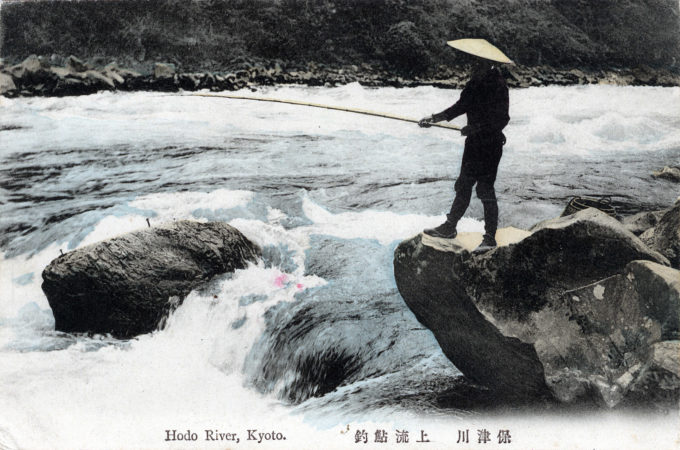
Hodo [sic] River, Kyoto, c. 1910. The Hozu River is known primarily for its association with Hozugawa kudari, literally ‘down the Hozu river’, a sightseeing whitewater boat ride downstream from Kameoka to Arashiyama.
See also:
The Hodzu Rapids, Kyoto, c. 1910
In the Rain of Arashiyama, Kyoto, c. 1910
“The person who taught me how to fish was an old man named Sato Koseki.
“Years ago Koseki took me fishing along the Sagami River and the streams of Masutomi, but at the time I found the sport strangely depressing. One July, however, he again took me along with him, this time to the Fuji River, where we fished for ayu. Ayu are small trout-like fish about nine inches long. They tend to travel in pairs, and the way to catch them is not to use ordinary bait but to string a live ayu on your line in the hope that it will attract a companion to the hook. On this trip I caught several, and Koseki flattered me by saying I showed a great deal of promise. His praise was enough to make a fisherman of me.
“Koseki showed me how to hold the pole, how to confront the river, how to stand, and how to land a ayu.
“Standing there by the gently flowing river and displaying his own skill, he said, ‘There are several ways to fish for ayu, but I’m convinced after forty years of experience that mine’s the best. You’ve just pulled one in the way I told you without any trouble. But, next year, after you fished some more, you’ll probably want to add a few tricks of your own, and after you do you’ll gradually get so you don’t catch anything.
“By the third or fourth year you’ll be in a real slump – no good at all. So you’ll keep changing your technique year after year until around the tenth year, and then you’ll decide to start fishing this way again. By that time you’ll feel like you’ve discovered this method yourself.’
“‘It’s like writing: You try this, this, and the other style, but in the end you always come to the conclusion that Matsu Basho’s style was the best after all.'”
– “My First Year’s Fishing”, by Ibuse Masuji, Japan Quarterly, Vol. IV No. 3, July-September 1957

